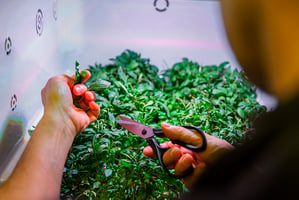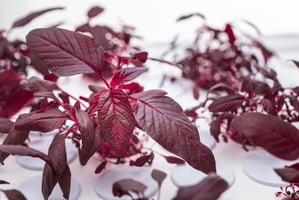7. Artificial light: what are LEDs for growth (and why they are critical in hydroponics)
Light is the engine of photosynthesis. In an indoor hydroponic system, where natural light is insufficient or completely absent, lighting quality directly determines growth speed, yield and final product quality.
This is why LEDs for growth are one of the most important elements of the whole system.
In this article we look at how they work, why they are different from traditional LEDs, and how Tomato+ has developed lighting specifically designed to maximize performance, sustainability, and automation.
Why LEDs for growth are different from household LEDs
A traditional LED illuminates according to human visual perception.
An LED for growing, on the other hand, is designed to maximize photosynthesis, with completely different characteristics:
1. Dedicated light spectrum for plants
Plants use more efficiently mainly:
-
Blue light (400-500 nm)
-
Red light (600-700 nm)
This gives rise to "photosynthetically active" spectra designed to stimulate growth, structure and yield.
2. High intensity and uniformity
Photosynthesis requires a minimum level of PPFD.
Household LEDs generate lux, while plants need photons (µmol).
A grow LED distributes uniform and specific light over the entire growing area.
3. Real energy efficiency (µmol/J).
In horticulture lighting, the key parameter is not lumens but micromoles per joule: how many useful photons each watt consumed produces.
How the plant changes with proper lighting
Well-designed agricultural lighting allows:
-
faster growth
-
more structured and consistent leaves
-
more intense color
-
higher aromatic content
-
reduced stresses
-
higher and more predictable yield
In many cases, proper lighting increases the speed of development by 30-50% compared to an uncontrolled environment.
Why light is the real bottleneck in hydroponics
In hydroponics, the plant receives nutrients, water and oxygen in perfect form.
When everything is optimized, light becomes the most limiting variable.
Insufficient light causes:
-
slow growth
-
pale leaves
-
spindly plants
-
lower yield
A proper LED is therefore as crucial as the nutrient solution or water system.
How to choose a good LED for growth
The main criteria for a quality LED are:
✔ Full and balanced spectrum.
Blue, red, far-red, and a white component for balanced morphology.
✔ PPFD consistent with variety.
Lettuce and microgreens require less light than basil, aromatics, and more demanding plants.
✔ Cooling and durability
An LED working at low temperature lasts longer and keeps the spectrum constant.
✔ Efficiency (µmol/J)
The higher the efficiency, the less energy is needed to produce the same amount of useful light.
How Tomato+ uses light to maximize yield, efficiency, and consumption
Tomato+ uses a proprietary lighting system with 6 independent light channels, whereas many conventional agricultural LEDs operate on 3 channels.
This approach allows it to:
-
more accurately emulate sunlight
-
tailor the lighting to each individual variety
-
manage different plant mixes in the same cycle
-
modulate the spectrum in real time through Growth Plans
-
avoid energy waste by lighting only with frequencies that are truly useful
AI: light gets smart (only on Horto Professional)
In more advanced versions, such as Horto Professional, light is not fixed:
it is automatically adjusted by AI based on:
-
images collected from integrated cameras
-
environmental data
-
actual growth rate
-
possible plant stresses
The lamp is not just an LED: it is an intelligent Growth Plan actuator, in continuous dialogue with the cloud.
Liquid cooling (Horto Professional): unprecedented efficiency
Traditional LEDs generate a lot of heat, and this heat has to be removed by the room air conditioner, increasing overall energy consumption.
On Horto Professional, on the other hand, LED modules use built-in liquid cooling.
This leads to three crucial advantages:
-
Heat is removed directly from the lamp, without heating the room.
-
The load on the air conditioner is dramatically lowered.
-
Total greenhouse consumption is reduced by up to 50 percent compared to air-cooled systems.
The result is a more stable, efficient and predictable ecosystem.
The future: controlled light, predictable growth
Artificial light is no longer an accessory, but the basis of modern indoor agriculture.
Those who want to grow seriously in hydroponics must consider lighting quality as one of the most critical variables for professional results.
With systems like Tomato+'s, light is not just energy: it is intelligence, efficiency, and sustainability, integrated into a single platform.
Thank you for reading this article. Keep following us to discover new content on hydroponics, vertical farming, and smart agriculture.
Tomato+ Team


